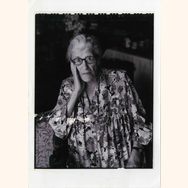Miriam Louisa Rothschild (1908-2005)
Dame Miriam Louisa Rothschild, born on 5 August 1908, was the eldest child of Nathaniel Charles Rothschild and Rozsika von Wertheimstein.
Career a as a natural historian
Miriam was a zoologist, entomologist and parasitologist who was a world authority on fleas, butterflies, pyrazines and chemical communication. Lacking a formal education, she was inspired by the work of her father and uncle. Miriam studied zoology at Chelsea Polytechnic, now part of King’s College, London. Her early work was as a marine biologist, specifically looking at larval trematodes. Following bomb damage to her research material while living in Plymouth during the Second World War and a later move inland, Miriam turned her attention to fleas. She investigated the jumping mechanism of the plague carrying flea Xenospylla cheopis, a species first described by her father, Charles Rothschild, in 1903. Later, in connection with her research on the rabbit flea as a vector of myxomatosis she discovered that its breeding cycle was controlled by that of its host. Miriam co-authored a collection of volumes detailing the taxonomy and morphology of her father’s collection of fleas. Miriam was also interested in the ways in which insects consume and store toxins from food plants, specifically in the context of butterflies and this research led to allied examinations of warning coloration and mimicry.
Nature conservation and social causes
In addition to her academic work, Miriam championed nature conservation and was actively involved in a broad range of civic, social and political causes, including providing scientific evidence to the Wolfenden Committee whose report assisted in decriminalising homosexuality. She was active in the field of mental health, establishing the Schizophrenia Research Fund. Miriam’s garden at Ashton Wold in Northamptonshire was described as ‘an outstanding example of wildflower and grassland gardening’. Her expertise in nature conservancy led to her advising HRH Prince Charles, the Prince of Wales when he was creating an experimental wildflower meadow at his Highgrove Estate. She was editor of Novitates Zoologicae between 1938 and 1941; a journal of zoology established by her uncle, Walter, 2nd Lord Rothschild, in 1894 which was published by the Tring Natural History Museum. She was with the Foreign Office between 1940 and 1942. During the Second World War, she joined a group of distinguished scientists, linguists and other personnel at the British Government Code and Cypher School at Bletchley Park, where she worked as a translator. She received a Defence Medal in 1945 from the British Government for her work. She aided refugee Jewish scientists during and after the war and she also worked with several organisations dedicated to helping Jewish children escape from Germany and Austria, often housing some of these refugees in her own home at Ashton Wold, Oundle, Northamptonshire, which was used by the Red Cross as a convalescent hospital for military personnel.
Scientific publications and recognition
Dame Miriam published over three hundred scientific papers during her lifetime. Having been educated at home from a young age, she was awarded several honorary degrees throughout her life including Doctor of Science (D.Sc.) by Oxford University in 1968, Doctor of Science (D.Sc.) by Göteborg University, Göteborg, Sweden, in 1983, and Doctor of Science (D.Sc.) by Cambridge University in 1999.
Dame Miriam was also decorated with several awards in recognition of her work. She was decorated with the award of the Bloomer Award (of the Linnean Society) in 1968, the Wigglesworth Gold Medal (of the Rota Entomological Society) in 1982, and she was invested as a Commander, Order of the British Empire (C.B.E.) in 1982. In 1985 she was invested as a Fellow, Royal Society, and became, with her brother Victor, the only brother and sister to have both been made Fellows of the Royal Society. She was decorated with the award of the Victoria Medal of Honour (of the Royal Horticultural Society) in 1991 and was decorated with the award of the Mendel Award (of the Czech Science Academy) two years later in 1993. She was invested as a Dame Commander, Order of the British Empire (DBE) in 2000.
Dame Miriam died 20 January 2005, aged 96.
Dame Miriam was Sue Lawley's guest on Desert Island Discs, on 23 April 1989. Listen to the broadcast on the BBC website here.
